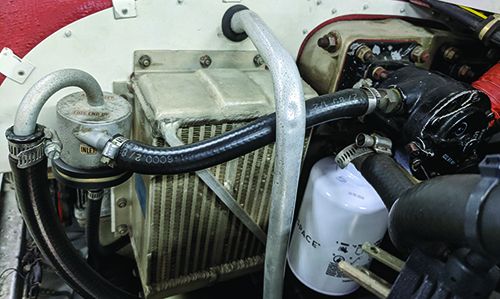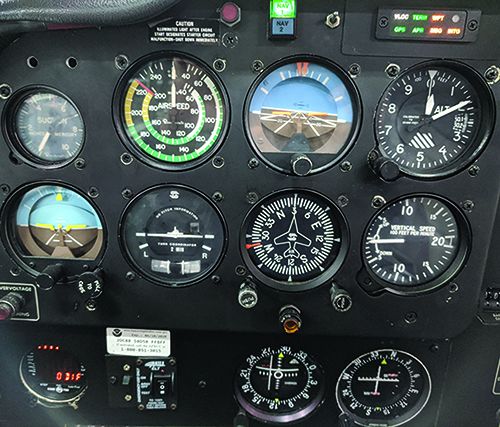Editor’s Note: This is the first in an occasional series of articles exploring the details and considerations of replacing conventional mechanical flight instruments with their electronic counterparts aboard a typical piston-powered personal airplane. While the series will necessarily involve comparing products, it also will evaluate the implications for operations and safety.
My personal airplane is a prime candidate for an upgrade to microprocessor-based flight instruments. It’s on all the Approved Model List Supplemental Type Certificate (AML-STC) lists for the various realistic options, and it has IFR-approved WAAS GPS navigation capabilities, with ADS-B Out and In. It also has a popular two-axis autopilot, which can be made to interface with just about anything.
The airplane’s current flight instruments are the basic “six-pack” of round mechanical gauges, including two vacuum-powered, mostly featureless gyros, an airspeed indicator and altimeter, plus a turn coordinator (required for the autopilot) and a vertical speed indicator. I also have an electric attitude indicator, installed as a back-up, plus a vacuum-system gauge. The image below shows the relevant portion of the airplane’s instrument panel as it is presently configured.
OBJECTIVES
So…what am I trying to achieve? One objective I have in “going glass” is eliminating the airplane’s vacuum system and related instruments. Doing so also will eliminate the potential for vacuum system failure, which has an obvious safety impact. It was a different airplane, but I have had a vacuum system failure—in severe VFR. In my installation, the vacuum pump is the so-called “wet” type, with internal lubrication handled by engine oil.
This set-up differs from “dry” vacuum pump installations by requiring the appropriate fittings and hoses to tap engine oil and circulate it through the pump, preferably combined with an air/oil separator to remove moisture from the oil flowing back to the engine. My airplane’s installation, including the air/oil separator and associated hoses, is shown in the image at right.

Except for overhauling the pump itself at the same time I did the engine, the system has never given me a moment of trouble in more than 20 years of ownership. Since wet pumps are more reliable than dry ones, removing it in favor of glass should not offer the same potential reliability gains that might otherwise be the case. There will be a weight savings from removing the vacuum pump, panel-mounted suction gauge, air/oil separator and associated plumbing, of course, but it won’t be much greater than if a dry pump was installed. Call it a pound.
The central objective, of course, is to leverage the huge advances in situational awareness and automation offered by all-electronic flight instrumentation. While I have enough moving maps helping me with situational awareness, overlaying navigation and terrain data with flight instrumentation is something I’d also like to get out of the bargain. Reliability also should be improved, if for no other reason than electronic instruments typically have no moving parts.
A subsidiary objective is to add to the airplane’s equipment an air data computer connected to the Garmin 530W. The principal benefit of such a feature would be to present true airspeed on the 530 and/or the wind vector on the new equipment. Some kind of attitude/heading sensor also will be part of the package, replacing the installed attitude indicator and directional gyro. An additional objective is to add GPSS—GPS steering—functionality for crisper autopilot response.
Those are my minimum requirements/objectives, all of which should be realistic, given the products currently on the market. Note that I’m not wedded to replacing all six of the flight instruments with a large-screen panel. One reason is that I’m sufficiently old-school that I actually like having some steam gauges laying around. Another reason is redundancy, which I’ll come back to in a moment.
A final consideration is how big a check I’ll have to write. Modern avionics have evolved well past the point that greater functionality costs less in real dollars than, say, 20 or so years ago, but they’re still not free.
REDUNDANCY/RELIABILITY
One consideration I haven’t resolved yet is the need for redundant instruments and/or power source. Basically, that’s because the solution I choose will have its own requirements for standby instrumentation, which can’t be determined until I make the choice. But it’s clear that some backup/standby scheme will be necessary.
Of course, going “all-electric” means a potential electrical failure could leave me without any instrumentation. Typically among these products, that outcome is mitigated with dedicated batteries designed to power the instrument for up to four hours. That should be more than enough time to get on the ground, but a battery backup doesn’t help with an equipment failure. When paired as shown on the previous page, Garmin’s G5 can be configured to present the failed instrument’s information, but that still leaves one with a partial-panel situation.
A typical factory-installed glass panel will have steam gauges providing airspeed, attitude and altitude as backups, but their mounting differs and, when placed on the far side of the panel, can be problematic. I don’t trust backup instrumentation solutions based on portable devices, if for no other reason than they often require pre-flight configuration and depend on an internal battery for power.
BENEFITS AND RISKS
I’d like my solution to work and play well with other avionics. In my case, that means deriving navigation data from the 530W and KX-155 nav/comm, and ADS-B traffic and weather from the already-installed L3 NGT-9000 transponder. In my mind, no “glass” solution is complete if it can’t interface with the available navigation data nor display traffic and weather. The same is true for the autopilot and GPSS capability. I’d prefer to have these capabilities with the initial installation, instead of waiting for software upgrades or the like.
The benefits side of this complicated equipment equation are a bit difficult to nail down from my current 30,000-foot view. That’s especially true when considering that no new operational capabilities would be available: The airplane already has ADS-B Out, plus traffic and weather, and can shoot any approach I’m likely to need. The autopilot does its job well and coupled approaches are a simple matter of correctly configuring the existing equipment. None of that will change.
What will change is I’ll no longer be challenged by the Achilles heel of vacuum-driven gyro instruments. I’ll be trading that challenge for the different—and slightly increased—risk of an equipment failure. I’ll also be chaining myself to new and different ways of doing things, which will require some yet-to-be-identified amount of training and practice before I’m comfortable flying in complicated airspace or in hard IFR.
DECISIONS, DECISIONS
At least for me, this is a big decision, involving not only money but down time, resale value and peace of mind. It also will change the ways I fly the airplane, hopefully while enhancing situational awareness. If the available systems can be integrated to my liking, I will have successfully dragged my 50-year-old airplane into the 21st century.
For many airplane owners, the considerations I’ve touched on here are nothing new. Identifying them, airing them and noodling through them should be part of any avionics upgrade. Subsequent articles will dive even deeper into this decision-making process.
Related Stories
Garmin International GI 275
Garmin International G5
Aspen Avionics Evolution ES
Dynon Skyview HDX




